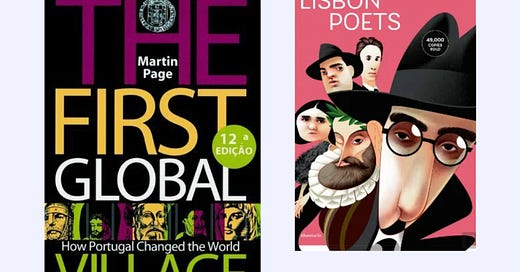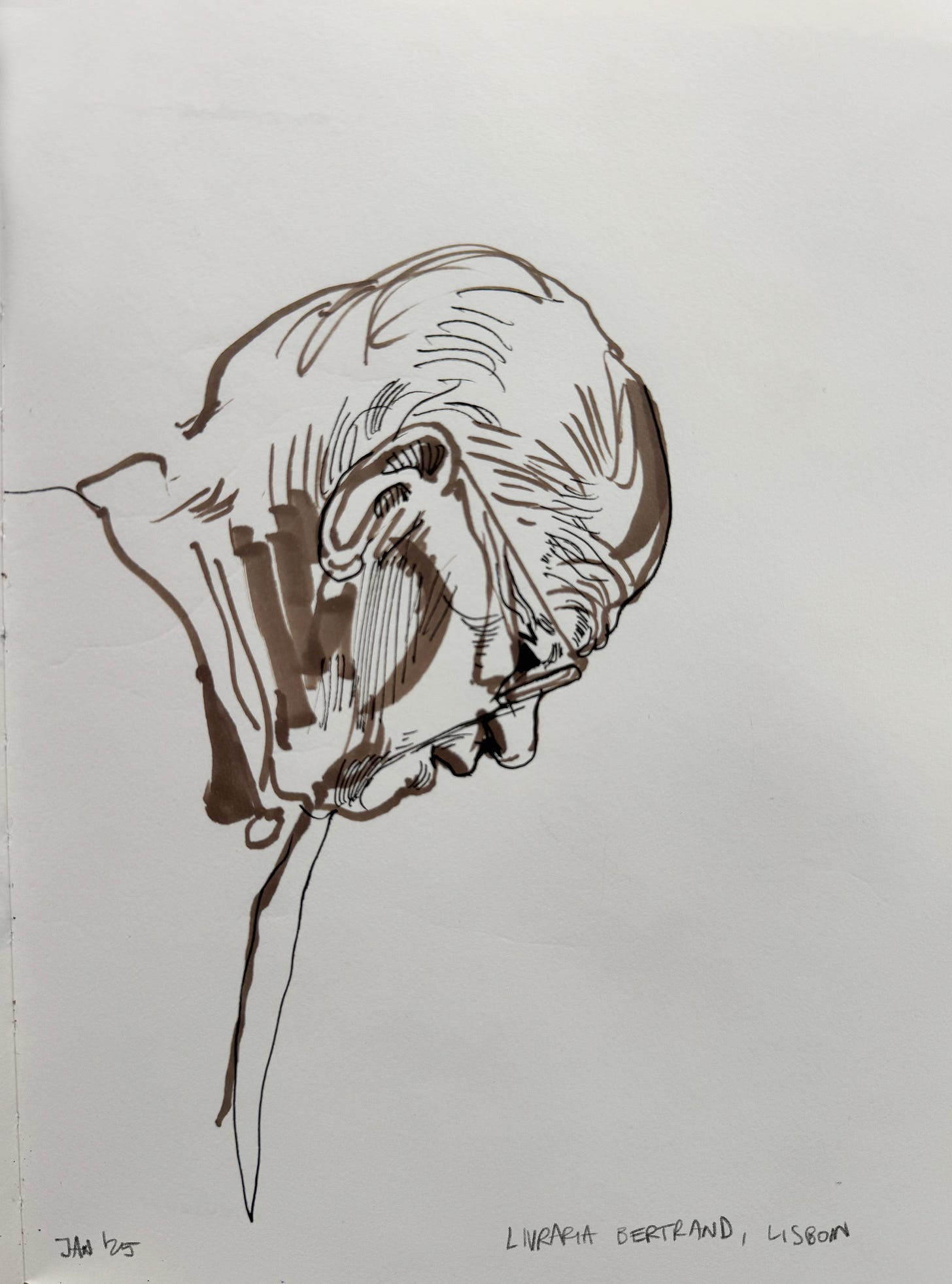Every place I return to has a couple of corners I need to pay a visit, a habit probably connected to nostalgia1.
In Lisbon, we are usually looking for Airbnb’s in the triangle formed by Penha Franca, Moorish Quarter and Alfama (East of Sao Jorge Castle).
From there I can start my morning running routine on the waterfront path connecting Praça do Comércio with Ponte 25 de Abril2.
Then there’s Landeau Chocolate on Rua de Flores, and their famous melting-in-your-mouth chocolate cake. First, the cocoa powder on top is cooling your palate and opens the way for the chocolate melting like a lava torrent. They both combine in a way never encountered before.
Next is Livraria Bertrand, also in Chiado, the oldest operating bookstore in the world, I always pay a visit and buy some books (Jan 2025 books below). Nothing more soothing than the view of a crowded bookstore. If it’s in Lisbon, that’s even better.
(Cover of Lisbon Poets created by a Portuguese illustrator I do admire, André Carrilho)
In front of the bookstore, I notice a nice gentleman, looks like a retired lawyer heading home, I decide to take a shot to draw him later. (here’s a sketch).
I am in love with the medium-spicy Sardines soup at the casual eatery Loja das Conservas Petiscos on Travessa Cotovelo (not at the shop but at the restaurant next to it).
A couple of hundred meters from Loja, there’s probably the best coffee in Lisbon, at Baobá Café Bica (next to the famous Ascensor da Bica3).
Not returning to every single time, but also worth visiting, of course, the complex Calouste Gulbenkian Museum - I remember seeing the vast permanent collection of Gulbenkian4 and a visiting show - Floating world: ‘ukiyo-e’ Japanese prints and it was incredibly rewarding. The Museum’s building itself is an architectural marvel5. Recently (Sep 2024), the Modern Arts Center at the Gulbenkian was redesigned by Kengo Kuma.
What is your favourite place in Lisbon?
Send me a list if you have some favourite spots in Lisbon.
The END
Nostalgia - Greek nostos ‘return home’ + algos ‘pain.
The Carnation Revolution (Portuguese: Revolução dos Cravos), also known as the 25 April (Portuguese: 25 de Abril), was a military coup by military officers that overthrew the authoritarian Estado Novo government on 25 April 1974 in Lisbon,[2] producing major social, economic, territorial, demographic, and political changes in Portugal and its overseas colonies through the Processo Revolucionário Em Curso. It resulted in the Portuguese transition to democracy and the end of the Portuguese Colonial War. [Wikipedia]
The Bica Funicular (Portuguese: Ascensor da Bica), sometimes known as the Elevador da Bica (Bica Lift), is a funicular railway line in the civil parish of Misericórdia, in the municipality of Lisbon, Portugal. It connects the Rua de São Paulo with Calçada do Combro/Rua do Loreto, operated by Carris. The line conforms to the funicular principle, with two cars permanently attached to opposite ends of a haulage cable, which is looped over a pulley at the upper end of the track. The cable links the two cars together so that they ascend and descend simultaneously, each car acting as a counterweight for the other one. [Wikipedia]
Calouste Gulbenkian (born March 29, 1869, Istanbul, Turk.—died July 20, 1955, Lisbon, Port.) was a Turkish-born British financier, industrialist, and philanthropist. In 1911 he helped found the Turkish Petroleum Co. (later Iraq Petroleum Co.) and became the first to exploit Iraqi oil; his 5% share made him one of the world’s richest men. From 1948 he negotiated Saudi Arabian oil concessions to U.S. firms. He amassed an outstanding art collection of some 6,000 works, now in Lisbon’s Calouste Gulbenkian Museum. The Lisbon-based Calouste Gulbenkian Foundation supports activities worldwide in science, art, social welfare, cultural relations, health, and education. [Encyclopaedia Britannica]
A defining mark in Portuguese museum architecture, the building of the Gulbenkian Museum is organised around two gardens with numerous tall picture windows that enable the visitor to enjoy Nature and Art together. A noteworthy example of the latest trends in modern Portuguese architecture of the 1960s, the Calouste Gulbenkian Foundation was awarded the Valmor Prize for Architecture in 1975, and classified ‘National Monument’ in 2010.
CAM’s building has been redesigned by Japanese architect Kengo Kuma, who collaborated with landscape architect Vladimir Djurovic to perfectly integrate architecture and nature. Kengo Kuma completely reimagined the previous CAM – Centro de Arte Moderna Gulbenkian building, designed by British architect Leslie Martin and inaugurated in 1983. This major reconfiguration of CAM is part of a wider project that aims to establish a greater connection between the building and the Gulbenkian Garden.





